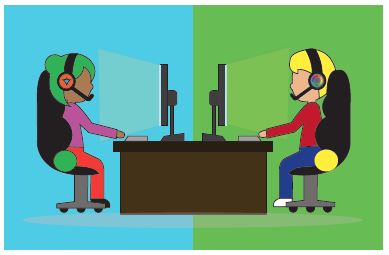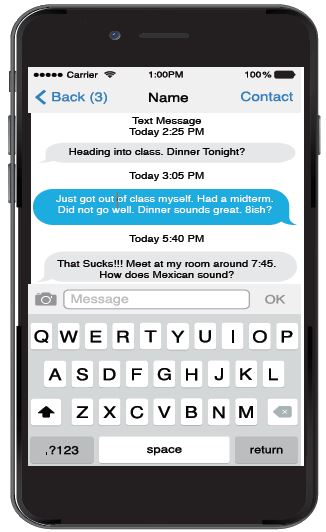Chapter 9: New Media & Communication
9.1 Mediated Contexts
Interpersonal Communication in Mediated Contexts[1]
In today’s world, we all spend a lot of time on various devices designed to make our lives easier. From smartphones to social media, we are all in constant contact with family, friends, coworkers, etc. Since the earliest days of communication technologies, we have always used these technologies to interact with one another. This chapter will examine how technology mediates our interpersonal relationships.

Allowing People to Communicate
The early Internet was not exactly designed for your average user, so it took quite a bit of skill and “know how” to use the Internet and find information. Of course, while the Internet was developing, so was its capability for allowing people to communicate and interact with one another. In 1971, Ray Tomlinson sent a message from one computer to another computer sitting right next to it, sending the message through ARPANET and creating the first electronic email. In addition to email, another breakthrough in computer-mediated communication was the development of Internet forums or message/bulletin boards, which are online discussion sites where people can hold conversations in the form of posted messages. As you can see, from the earliest days of the Internet, people were using the Internet as a tool to communicate and interact with people who had similar interests. Today, there are hundreds of ways to connect with others in an online environment.
Synchronous and Asynchronous Communication
Synchronous communication happens in real time, like having a class discussion in a face-to-face setting or talking to a someone after class. But you can communicate synchronously in an online environment too, through the use of tools like online chat; Internet voice of video calling systems like Skype or Google Hang-outs; or through the use of web-based video conferencing software like WebEx, Zoom, or Collaborate. Another popular form of synchronous online communication is gaming. For example, in Figure 12.5, Sam and Pat are in some kind of underworld, fiery landscape. Pat is playing a witch character, and Sam is playing a vampire character. The two can coordinate their movements to accomplish in-game tasks because they can talk freely to one another while playing the game in real time.

Conversely, asynchronous communication is the exchange of messages with a time lag. In other words, in asynchronous communication, people can communicate on their own schedules as time permits instead of in real time. For example, Figure 12.6 shows a conversation between two college students. In this case, two college students are using SMS, commonly called texting) to interact with each other. The conversation starts at 2:25 PM. The first person initiates the conversation but doesn’t get a response until 3:05 PM. The third turn in the interaction then doesn’t happen until 5:40 PM. In this exchange, the two people interacting can send responses at their convenience, which is one of the main reasons people often rely on asynchronous communication. Other common forms of asynchronous communication include emails, instant messaging, and online discussions.

New Media
The early 1980s saw the development of what we call the new media: new technologies and old technologies in new combinations. They are muddying if not eliminating the differences between media. On the iPad, newspapers, television, and radio stations look similar: they all have text, pictures, video, and links.
Increasingly, Americans, particularly students, are obtaining information on tablets and from websites, blogs, discussion boards, video-sharing sites, such as YouTube, and social networking sites, like Facebook, podcasts, and Twitter. And of course, there is the marvel of Wikipedia, the free encyclopedia to which so many people (four hundred million every month) go to for useful, if not always reliable, information.
Netiquette
Over the years, numerous norms have developed to help individuals communicate in the CMC context. They’re so common that we have a term for them, netiquette. Netiquette is the set of professional and social rules and norms that are considered acceptable and polite when interacting with another person(s) through mediating technologies. Let’s break down this definition.
Contexts
First, our definition of netiquette emphasizes that different contexts can create different netiquette needs. Specifically, how one communicates professionally and how one communicates socially are often quite different. For example, you may find it entirely appropriate to say, “What’s up?!” at the beginning of an email to a friend, but you would not find it appropriate to start an email to your boss in this same fashion. Furthermore, it may be entirely appropriate to downplay or disregard spelling errors or grammatical problems in a text you send to a friend, but it is completely inappropriate to have those same errors and problems in a text sent to a professional-client or coworker. One of the biggest challenges many employers have with young employees who are fresh out of college is that they don’t know how to differentiate between appropriate and inappropriate communicative behavior in differing contexts. This lack of professionalism is also a problem commonly discussed by college and university faculty and staff. Think about the last email you sent to one of your professors? Was this email professional? Did you remember to sign your name? You’d be amazed at the lack of professionalism many college and university faculty and staff see in the emails sent by your peers.
Rules and Norms
Second, our definition of netiquette combines both rules and norms. Part of being a competent communicator in a CMC environment is knowing what the rules are and respecting them. For example, if you know that Twitter’s rules ban hate speech, then engaging in hate speech using the Twitter platform shows a disregard for the rules and would not be considered appropriate behavior. In essence, hate speech is anti-netiquette. We also do not want to ignore the fact that in different CMC contexts, different norms often develop. For example, maybe you’re taking an online course and you’re required to engage in weekly discussions. One common norm in an online class is to check the previous replies to a post before posting your reply. If you don’t, then you are jumping into a conversation that’s already occurred and throwing your two-cents in without knowing what’s happening.
Acceptable and Polite CMC Behavior
Third, netiquette attempts to govern what is both acceptable and polite. Yelling via a text message may be acceptable to some of your friends, but is it polite given that typing in all caps is generally seen as yelling? Being polite shows others respect and demonstrates socially appropriate behaviors. If you’ve spent any time online recently, you may have noticed that it can definitely feel toxic. There are many trolls, making the Internet a place where civil interactions are hard to come by. Mitch Abblett came up with five specific guidelines for interacting with others online:
1. Be kind and compassionately courteous with all posts and comments.
2. No hate speech, bullying, derogatory or biased comments regarding self, others in the community, or others in general.
3. No Promotions or Spam.
4. Do not give mental health advice.
5. Respect everyone’s privacy and be thoughtful in the nature and depth of your sharing.14
Think about your interactions with others in the online world. Have you ever communicated with others without considering whether your own intentions and attitude are appropriate?
Online Interaction
Fourth, our definition involves interacting with others. This interaction can be one-on-one, or this interaction can be one-to-many. The first category, one-on-one, is more in the wheelhouse of interpersonal communication. Examples include sending a text to one person, sending an email to one person, talking to one person via Skype or Zoom, etc. The second category, one-to-many, requires its own set of rules and norms. Some examples of common one-to-many CMC could include engaging in a group chat via texting, “replying all” to an email received, being interviewed by a committee via Skype, etc. Notice that our examples for one-to-many involve the same technologies used for one-on-one communication. However, the norms may be different for each.
Range of Mediating Technologies
Lastly, netiquette can vary based on the different types of mediating technologies. For example, it may be considered entirely appropriate for you to scream, yell, and curse when your playing with your best friend on Fortnite, but it wouldn’t be appropriate to use the same communicative behaviors when engaging in a video conference over Skype. Both technologies use VoIP, but the platforms and the contexts are very different, so they call for different types of communicative behaviors. Some differences will exist in netiquette based on whether you’re in an entirely text-based medium (e.g., email, texting) or one where people can see you (e.g., Skype, WebEx, Zoom). Ultimately, engaging in netiquette requires you to learn what is considered acceptable and polite behavior across a range of different technologies.
- Exploring Relationship Dynamics by Maricopa Community College District is licensed under a Creative Commons Attribution-NonCommercial-ShareAlike 4.0 International License, except where otherwise noted. ↵

